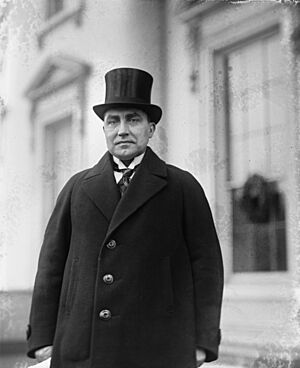Ants Piip facts for kids
Quick facts for kids
Ants Piip
|
|
|---|---|

Ants Piip, 1923
|
|
| 1st State Elder of Estonia | |
| In office 20 December 1920 – 25 January 1921 |
|
| Preceded by | himself as Prime Minister |
| Succeeded by | Konstantin Päts |
| 5th Prime Minister of Estonia | |
| In office 26 October 1920 – 20 December 1920 |
|
| Preceded by | Jaan Tõnisson |
| Succeeded by | himself as State Elder |
| Personal details | |
| Born | 28 February 1884 Tuhalaane, Kreis Fellin, Governorate of Livonia, Russian Empire |
| Died | 1 October 1942 (aged 58) Nyrobsky camp, Molotov Oblast, Soviet Union |
| Nationality | Estonian |
| Political party | Estonian Labour Party, later none |
| Profession | lawyer, diplomat, politician |
Ants Piip (born February 28, 1884, died October 1, 1942) was an important Estonian lawyer, diplomat, and politician. He was the very first leader of Estonia and also served as the fifth Prime Minister of Estonia. Ants Piip helped Estonia become an independent country on the world stage, especially after World War I at the Paris Peace Conference. He was arrested in 1941 and died while imprisoned in a Soviet camp.
Contents
Learning and Studies
Ants Piip grew up as the son of a small farmer. He worked hard to get an education. He finished high school at Kuressaare State High School. Later, he studied at the Teachers' Seminar in Kuldīga, which is now in Latvia.
- From 1903 to 1905, he worked as a clerk and teacher in Alūksne.
- He also taught at the Emperor Nikolai Eastern Orthodox Parish School in Kuressaare (1905–1906).
- He taught at the Kuressaare Marine School (1906–1912).
- From 1913 to 1915, he taught at the Janson Merchant School in Saint Petersburg.
Piip studied law at Saint Petersburg University from 1908 to 1913. He even received a special scholarship from the university. During this time (1913–1916), he worked in the Russian Justice and Interior Ministries. He also took extra classes at the Berlin University in 1912.
Ants Piip's Career
Ants Piip was a very active person in Estonian politics and international relations. He was a member of several important Estonian assemblies.
Early Political Roles
- He was part of the Estonian Province Assembly.
- Later, he joined the Constituent Assembly (Asutav Kogu).
- He also became a member of the Riigikogu, which is Estonia's parliament.
Diplomacy and Peace Talks
From 1917 to 1919, Piip worked for Estonia's Foreign Mission in Saint Petersburg and London. He was involved in the Paris Peace Conference. This was a big meeting after World War I where countries decided on peace terms.
In 1919, he was the Deputy (assistant) to the Minister of Foreign Affairs. From 1919 to 1920, he was part of the Estonian team. This team negotiated the Tartu peace treaty between Estonia and Russia. This treaty was very important for Estonia's independence.
Leading Estonia
- In 1920, he was Estonia's diplomatic representative in Great Britain.
- From 1920 to 1921, he served as the Head of State. During this time, he was also the Minister of War.
- He held the position of Minister of Foreign Affairs five times.
- From 1923 to 1925, he was Estonia's Envoy (a type of ambassador) to the United States of America.
- From 1938 to 1940, Piip was also a member of the Riigivolikogu, which was the first chamber of the Riigikogu.
Ants Piip was arrested on June 30, 1941. He died in a Soviet prison camp called NyrobLag the next year.
Important Quote
In 1934, Ants Piip spoke in Riga about how important it was for countries around the Baltic Sea to work together. He believed this cooperation would help them stay independent.
The law of history is the following: if the nations inhabiting the shores of the Baltic Sea are not able to create between themselves a stronger organisation, they are doomed inevitably to submit to a stronger European power of the respective period.
Awards and Honors
Ants Piip received several important awards for his service:
- 1920 – Cross of Liberty III/I
- 1926 – Order of the Three Stars I (Latvia)
- 1932 – Order of the Estonian Red Cross I/II
- 1934 – Order of the Cross of the Eagle I
- 1940 – Order of the White Star I

